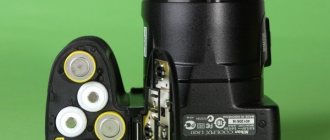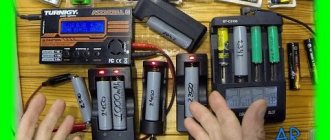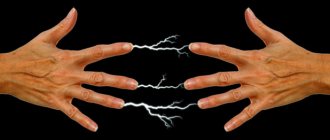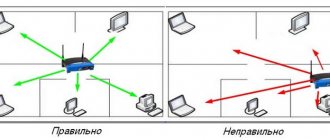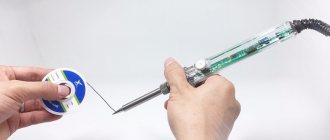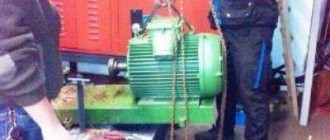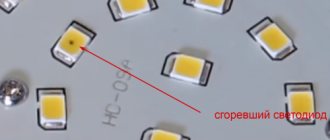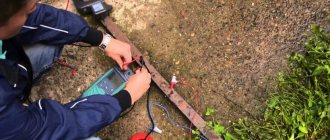Flashlights, digital players, voice recorders, digital watches, toys, remote controls and portable medical equipment - all these and many other devices are powered by power sources.
The design of power supplies is extremely simple: two electrodes - a negative anode and a positive cathode - are immersed in a container with electrolyte and packaged in a metal case.
When the contacts are closed, electrons begin to move from one electrode to another, creating an electric current. Over time, the supply of active substance at the anode is depleted, and there are fewer electrons. On the other hand, the ability of the electrolyte to conduct current decreases. This is why the battery drains.
Battery classification
Batteries differ in shape and internal composition, more precisely, in the type of chemical reaction that leads to the formation of electric current.
Types of batteries by shape
- The most familiar to us are “finger” (labeled AA) and “little finger” (labeled AAA). They are cylindrical in shape and power most types of electronic equipment.
- Elements of the “barrel” format (markings C and D) are also produced in the shape of a cylinder, only their sizes are larger, which provides a greater power reserve. Such sources are used, for example, in tourist lamps, radios, players and tape recorders.
- Rectangular galvanic cells, popularly called “crown” - after the name of a famous brand.
- Disc batteries (CR) - the so-called “tablet” batteries, are used in wristwatches, laser pointers, toys
The operating voltage of cylindrical batteries is 1.6 Volts. And the “crown” provides a voltage of as much as 9 volts.
By type of chemical reaction
- Saline. They are characterized by low power and can be stored from 1 to 3 years.
- Alkaline or "alkaline". The name comes from the imported Alkaline marking. They are able to cope with a more powerful load. Shelf life - from 3 to 5 years.
- Lithium. They cope best with high loads. Shelf life is from 5 to 7 years.
What batteries can be charged in the charger?
The chemical processes occurring in a conventional galvanic cell are irreversible. Having exhausted its resource, it stops producing electric current. It’s easy to identify them: usually on the body of such a battery there is the inscription “do not recharge” - “cannot be recharged”. The only way to extend its life is to try to place it in a less energy-intensive device. For example, batteries that are not suitable for a radio-controlled car may be suitable for operating a TV remote control.
The only type of battery that can be properly recharged a large number of times is rechargeable. They can be distinguished by the rechargeable battery marking. The operating voltage of rechargeable batteries is lower than that of conventional batteries - 1.2 Volts. Rechargeable batteries are more expensive than conventional batteries: the greater their power and the number of recharge cycles, the higher the price. In addition, you will need a special charger, which is purchased separately. Often these chargers are equipped with an indicator that will show how charged the battery is. Charging time for batteries is 8-12 hours.
Types of "frogs"
Today, universal chargers called “frog” chargers are commercially available. By design they can be divided into three large groups.
- Standard models. Receive power from AC mains. In Europe and Russia, devices that can withstand a voltage of 220V are used, in America - 110V.
- Automotive devices. Instead of a power plug, they are equipped with a connector for the cigarette lighter socket, and are powered from the vehicle’s on-board network.
- USB devices. They are equipped with a special socket and are used when the phone interface does not provide a USB port. In this case, the battery is inserted into a “toad”, which is connected to a computer or laptop via a cord.
Based on the type of functionality, chargers are divided into two categories:
- automatic – capable of changing the polarity of the battery independently;
- semi-automatic - charging requires connecting the battery to the terminals manually.
The vast majority of models are equipped with information displays or indicator lights, as well as additional connectors to expand the functionality of the device.
Recharging at home
The question arises: is it possible to charge alkaline batteries in a charger? There is a relatively safe way to charge an alkaline battery, but its effectiveness is questionable. For this emergency measure you will need a 4 battery charger. In the first three compartments from left to right we insert discharged alkaline cells that will be charged. And in the fourth (the one on the right) there is a battery. The duration of the “treatment” is from 5 to 10 minutes. After this, alkaline elements can be used again, but not for long.
Read also: What can copper be dissolved in?
Enthusiasts have come up with numerous ways to charge a AA battery at home. Of course, this is not a full recharge. After all, the chemical reactions themselves inside such a power source are irreversible. For example, if you gently crush the battery with pliers or tap it on any hard surface, this will slightly reanimate the electrolyte and extract a few extra percent of power. Just be careful not to damage the housing, otherwise the electrolyte will leak out and the power source will not work.
It is impossible to heat discharged galvanic cells - there is a high risk of explosion.
If you want galvanic cells to last longer, do not use them in the cold: they quickly lose their charge. Pay attention to the release date: batteries tend to self-discharge. You should not use different types of batteries at the same time, or use old ones with newer ones. This also reduces their service life.
We often miss good shots in the forest or at sea, we may be late or stumble in the dark because a simple battery from a camera, watch or flashlight suddenly runs out. It's hard to say exactly when the charge will be used up, unless this is a Duracell model with an indicator. But don't despair! Thanks to a few tips, you can avoid unpredictable situations and take the intended photographs from a digital camera, find out the exact time, illuminate the road, etc. In this article, we will tell you how to charge batteries at home without a charger, which will make life much easier in unpredictable situations.
Know that to charge alkaline batteries you can use a special charger that can relatively quickly restore a discharged item. But each charging session will reduce its operating life by approximately 1/3. In addition, leakage is possible.
Note! At home you can charge: alkaline (alkaline) AA batteries. Don't: salt. The possibility of leakage or even explosion cannot be ruled out!
Charging can be done using various methods. Therefore, you should not throw away an element as soon as it stops serving. A few recommendations - and he is back in action. The first method, using which you can charge AA batteries yourself without a charger. We connect the power supply to the network. Next, using the connection wires, we connect the used battery to the unit. Don't forget about polarity: plus is connected to plus, and minus is connected to minus. It’s quite easy to find where the “-+” is on a discharged object: they are marked on the body.
Having connected the battery to the power source, wait until it warms up to fifty degrees and turn off the power. Next, wait a few minutes for the heated object to cool down. Otherwise, it may explode. Then, while the AA is still warm, it needs to be charged in a different way. It consists of the following: connect the power supply to electricity and disconnect it. This should take about 120 seconds. Next, we place the object to be charged in the “freezer” for 10 minutes, then take it out and wait 2-3 minutes for it to warm up. That's it, the charge is restored right at home without a charger! You can safely use it for the same computer mouse.
Main rules:
- The charge is not feasible if you arrange the + and - in a different way. On the contrary, the battery will drain even faster.
- It is permissible to charge the object at home 1-2 times.
- Using the method described above, you can only charge simple AA alkaline batteries.
- The charge can be carried out in any ambient temperature conditions.
But it is fraught with consequences (explosion). In this way, you can restore, again, small alkaline batteries at home. You can also charge them in a simpler way - place discharged objects in hot water, but for no more than 20 seconds, otherwise sad results are possible. Another simple way is to flatten or reduce the volume of the element with your own hands. This way you can charge various AA batteries. There is an example when a person, after the charge of a cast-ion battery had expired, simply took it out and stomped on it, after which the charge indicator showed one hundred percent. Read also: Sharpening machine for metal turning tools
You can also restore the charge without a charger this way: we make 2 holes with an awl near each carbon rod with a depth of three-quarters of the height of the element itself. We pour liquid into them and seal them, covering them with resin or plasticine. You can pour not just liquid, but an eight to ten percent solution of hydrochloric acid or double vinegar. Pour the solution several times to ensure sufficient saturation. This method allows you to charge up to seventy to eighty percent of the initial capacity.
Another way to charge the product: open the cell cover with a knife. If the zinc cylinder, the object's rod and the carbon powder are intact, then immerse the object in the salt solution. Its ratio is as follows: 2 tablespoons of table salt per several glasses of liquid. Next, boil the solution together with the element for about ten to fifteen minutes. Then we return the gaskets responsible for sealing to their place and cover them with wax or plasticine.
In this article, we told you how to charge batteries at home without a charger. The proposed tips apply only to finger batteries, since they, unlike little finger batteries, flat batteries (tablets) used for lasers, are most often used in everyday life. Now you can properly charge the necessary elements even if there is no electricity!
Also read:
Did the battery from your camera, flashlight, children's toy or other necessary device suddenly run out? Such an eventuality cannot be foreseen. Unless you use special batteries with indicators. Or be careful not to carry a replacement with you. How to charge batteries at home? We will share with you useful instructions and recommendations.
DIY powerbank
Top
- To make a USB charger we will need:
- USB extension cable (any length, even 5-10 cm),
- cartridge for 4 AA batteries (bought on the market),
- diode (taken from a dead power supply),
- soldering iron, some flux and solder (for 30 minutes),
- multimeter (for 30 minutes),
- sealant or thick glue.
Manufacturing principle.
From the USB extension cable we leave only a socket with wires. It needs to be attached (for example, glued) to the cartridge body, and the wires coming from the contacts of the USB socket must be soldered to the pads and cartridge
respectively.
- Cartridge for 4 AA batteries:
In a correct USB cable, the contacts and are located at the edges of the connector, as indicated in the diagram. Usually there is a red wire coming from the contact, and a black wire coming from it. But to check, it doesn’t hurt to put the cut-off plug into the computer and measure the potentials with a multimeter. This option
the most reliable, because the Chinese sometimes screw this up...
To prevent reverse current, when charging occurs not in the forward direction, but in the opposite direction, we place a diode in the gap of one of the wires.
It is not required, but there are also devices that can remove 5 Volts from the charger connector (for example, some models of old Sony Ericsson).
In this case, if the cartridge contains dead batteries or accumulators, physics will try to equalize the potentials on the cartridge and the phone terminals. For
In such cases, a diode is needed.
To increase the strength of the connection, I wound the socket to the cartridge with steel wire, and filled the wires, diode and gaps with hot glue. This way, dirt will not get clogged, and the wires will not accidentally get caught on any protruding objects - after all, the operating conditions of the universal charger require placement on branches, backpacks, in tents and kayaks, etc. IN
The result was a completely independent device.
For example, let's connect a phone and a player to the cartridge. During the trip, we tested 2 players from different manufacturers. First, Ni-MH batteries were installed in the cartridge, and after they were depleted, a set of alkaline batteries was installed.
batteries.
Let me remind you that the self-discharge of Ni-MH batteries is about 5-8% per day. That’s why they should be used first. The batteries do not have significant self-discharge, and therefore can be used until the expiration date.
As for charging players that have a battery life of about 5-10 hours, the Acorp, shown in the photo, was successfully charged 5-6 times. The first two charges up to 100%. Then a little more than 70% capacity. And the last two charges gave just over 50% capacity.
The charging quality was assessed in comparison with the battery life when charging from
mains charger.
Why do the second and subsequent charges not reach 100% capacity? At first, the voltage from four batteries is 6 Volts (or 4.8 Volts for Ni-MH batteries).
Then the voltage on the cartridge drops, and it is no longer possible to charge the Li-ion or Li-Pol battery to 4200 mV.
But until the charge of the batteries or batteries in the cartridge is depleted, charging will continue until the battery potential of the device being charged
and cartridge will match.
With the phones, we managed to make three charges at 100%, 70-80% and 50-60%, respectively. But here the battery capacity is many times greater than that of players.
So everything is natural.
Method 1: Charger
We figured out whether the battery can be charged. If you constantly use such AA batteries, then the easiest way for you is to buy a special charger for them. Such a device will help “breathe life” into the battery without unnecessary hassle.
However, the method also has significant drawbacks. Each charge reduces battery life by one third. In addition, the procedure may cause leakage of its composition.
Method 2: Power Supply
Let's look at how to charge batteries at home. For this method, you will need a power supply and wires to connect to it. Everything is in place? Here are the instructions for action:
- First of all, connect the battery to the power supply with wires. It is important to maintain polarity here - connect plus with plus, minus with minus. This is easy - “+” and “-” are marked on the body of the used battery.
- After you have connected the battery, wait until it reaches 50°C. Then unplug it from the power supply.
- Be sure to wait a few minutes to allow the element to cool down. Otherwise, you can provoke its explosion!
- While the battery is still warm, reconnect it to the power supply for about 2 minutes.
- But now the element needs to be placed in the freezer for 10 minutes.
- After this time, remove the battery and wait a few minutes until it warms up to room temperature.
- That's it, the charge is restored! The element can be used for its intended purpose.
Read also: Making your own car antenna
When receiving a rechargeable AA battery using this method, pay attention to these recommendations:
- The process will not work if you reverse the polarity when connecting the wires. Moreover, in this way you will destroy the remaining charge in the element.
- Using the described method, the battery can be charged 1-2 times.
- The method is only suitable for finger-type alkaline cells!
- The procedure can be performed in any environmental conditions (with the exception of the freezer stage).
Charge your phone without using a charger
Most owners of mobile gadgets have no idea that, in some stores and outlets for other services, chargers are also on sale. In addition, there are terminals where you can charge your mobile phone. It’s a pity, but in our country, they are still available in two capitals and other large cities. But, if you find them, feel free to charge your phones!
Unfortunately, such charging costs money. On average, 50 rubles per hour. If you are walking along the central square and there is a store of your operator nearby, you can contact him with such a request. You should not be refused, since such a service is part of the service provided to subscribers of your network.
But, for the most part, there will be no such service. In this case, let's try to charge the phone without a charger. You can simply use the Air function. In this situation, you can fully charge your smartphone after an hour. If this option does not suit you, then you can recharge your smartphone a little if you turn off the Internet and the GPS network. Only your card should work. However, programs need to be disabled.
Method 3: Heating
You can also restore the battery charge by regular heating. But be careful - this method can cause the product to explode!
The simplest thing is this:
- Fill a container with hot (but not boiling) water. Put batteries there.
- How long does it take to charge batteries this way? Keep them in water for no more than 20 seconds so as not to provoke sad consequences!
- Wait until the battery is completely dry and cools down to room temperature. That's it, you can use it!
Types of batteries
Repeated recharging is only available for batteries that have 3-4 digits indicating their energy capacity on the body in large print.
Depending on the “chemistry” used and the method of discharging the charge, the following types of batteries are distinguished:
Types of batteries.
- lithium-ion;
- lithium polymer;
- nickel metal hydride;
- nickel-cadmium;
- nickel-zinc.
Let's look at the features of the most popular ones:
- lithium-ion (Li-Ion). The most energy-intensive, at the same time compact, lightweight and capable of quickly releasing energy. They discharge more slowly compared to other types, and can be stored longer in a “shrunken” form. The price is more expensive than other batteries, since more environmentally friendly materials are used in production. But you can’t just throw away an “outdated” battery - just recycle it;
- nickel metal hydride (Ni-MH). Their characteristic feature is the duration of operation without additional recharging. They are charged when the capacity is completely depleted. But they do not store a charge for long;
- nickel-cadmium (Ni-Cd). A “weak” but accessible type, which is charged only when completely discharged, otherwise the energy intensity drops noticeably. Advantages of the products: they remain operational in heat, cold, and temperature changes. Charges and discharges quickly. Since cadmium is a toxic substance, recently batteries with such “chemistry” are used less and less often.
Method 4: Volume reduction
The method is quite incomprehensible and exotic at first glance. We need to reduce the size of the battery so that the charge in it is restored on its own.
What should you do for this? Mechanically reduce and make the body volume thinner. To do this, the battery is hit against something hard - asphalt, wall, stone, brick, etc. Or they simply trample on it with thick shoes. You can try to flatten it with a handy tool - for example, pliers.
This method will charge all AA batteries. It must be said that such a “barbaric” method helps restore the charge in some cases even to 100%!

